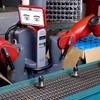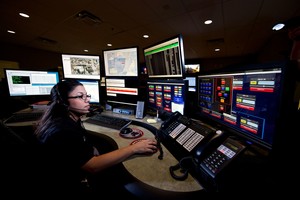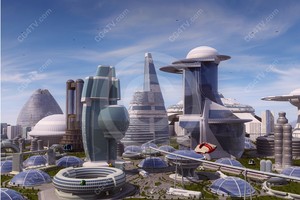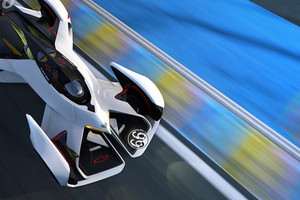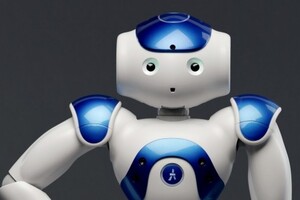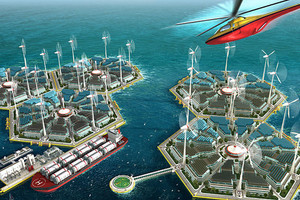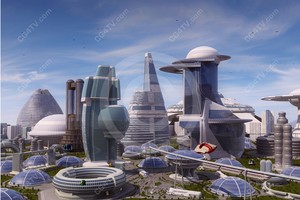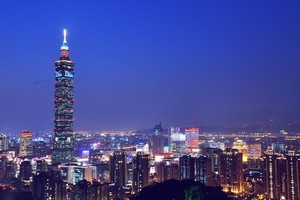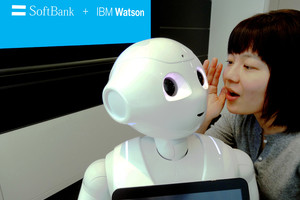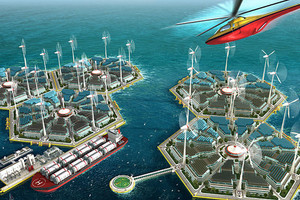Editor Uno
Ten Ways 3D Printing Will Transform The Way We Live And Work
A few years ago, the office printer was in danger of becoming a dusty relic from a bygone era; like a floppy disk trying to stay relevant in an all-digital world. Then “3D” happened. All of a sudden, printers are one of the hottest and fastest-growing technologies on the planet and it’s all thanks to the third dimension. Here are ten ways 3D printing is improving how we work and live.
- 13.08.2015, 10:20 von Editor Uno
- 0 Kommentare
- 16.925 Aufrufe
3D printing and fashion: How the tech is being used and what to expect going forward
3D Printing is taking fashion by a storm! What lawyers need to know
Craftsmanship and handiwork is not necessarily eliminated with the advent of 3D technology and a sea change is coming to luxury brands in particular. Initially, fashion brands were quite skeptical about 3D printing, likening it to a copy machine on steroids and not a technology that can produce items to which a designer can feel proud or a consumer can feel luxe. While Chanel has just announced its embrace of 3D printing in its July, 2015 Paris fashion show by showcasing tweed jackets that were created using the technology, it is not the first brand to use 3D printing to fashion (pun intended!) some terrific wares. Currently, fashion brands are learning about the technology in order to determine whether to strategically use it or to reject it.
- 13.08.2015, 09:54 von Editor Uno
- 0 Kommentare
- 334.986 Aufrufe
Das Auto als Internet-Hardware
Bis zu 80 unterschiedliche Systeme werkeln in manchen Autos. Die Komplexität ist kaum noch zu beherrschen. Im Rahmen des vom Bundesministerium für Bildung und Forschung (BMBF) mit insgesamt 7,1 Mio. Euro geförderten Forschungsvorhabens „Visio.M“ haben Forscher der Technischen Universität München (TUM) ein zweischichtiges IT-System entwickelt, das die Komplexität drastisch reduziert. Die zugehörige Software, den „Automotive Service Bus“, stellen die Wissenschaftler nun als Open Source Lizenz zur Verfügung.
- 13.08.2015, 09:04 von Editor Uno
- 0 Kommentare
- 10.200 Aufrufe
Selbst gebaut, selbst versorgt: Das Öko-Haus "Earthship" landet
Ein ungewöhnliches Gebäude, das Earthship, soll bald bei Crailsheim „landen“. Die Organisation Earthship Biotecture will das Passivhaus aus recycelten oder natürlichen Materialien bauen und dabei möglichst unabhängig von Strom-, Gas- und Wassernetz bleiben.
- 13.08.2015, 08:51 von Editor Uno
- 0 Kommentare
- 1.237 Aufrufe
The Future of Work: Uniting Workers in the Gigging Economy
The latest entry in a special project in which business and labor leaders, social scientists, technology visionaries, activists, and journalists weigh in on the most consequential changes in the workplace.
A few days ago, a stranger sat down on a park bench beside me and asked me to help him make a decision. He’d been offered a good job—a good salary, full benefits, and equity—managing a team at a prominent tech company. But like most of the workers at the company, his team would be composed of contractors, who would receive no benefits; they wouldn’t even be allowed to eat the catered lunch provided to the small number of regular employees. Besides the difficulty of retaining and motivating his team, he struggled with the ethics of a business model that would extract value from the people working for him but not provide them with the economic security that he and other high-level employees would enjoy.
- 12.08.2015, 19:47 von Editor Uno
- 0 Kommentare
- 14.323 Aufrufe
Können Roboter Menschen trauen?
Die Weltreise von HitchBOT, dem trampenden Roboter, ist vorerst vorbei. Unbekannte beschädigten ihn in Philadelphia zu stark. Trotzdem ist das Projekt ein großer Erfolg.
Von seiner Reisewunschliste in den USA konnte HitchBOT nur die ersten beiden Punkt abhaken: Die Lichter am Times Square in New York bewundern und bei einem Sport-Event jubeln. Die übrigen 14 Ziele – etwa schlaflos in Seattle zu sein, die großartige Aussicht am Grand Canyon zu genießen, Disney World in Florida zu besuchen oder Jazz-Musik in New Orleans zu lauschen – wird das sympathische Kerlchen nicht mehr erreichen (sein Name leitet sich vom Ausdruck "to hitch a ride" ab, was so viel bedeutet wie "eine Mitfahrgelegenheit finden"). Unbekannte beschädigten HitchBOT in Philadelphia so stark, dass er seine Reise nicht mehr fortsetzen kann. Doch das scheint ihn nicht groß aus der Bahn zu werfen: "Manchmal wiederfährt guten Robotern auch etwas Schlechtes", ließ er die Fans auf seiner Webseite wissen. Das Projekt sei nur vorläufig vorbei.
- 12.08.2015, 19:36 von Editor Uno
- 0 Kommentare
- 9.748 Aufrufe
Building Self-Driving Cars That Drive Ethically
Autonomously driven automobiles have logged hundreds of thousands of miles in the research stage, mastering a somewhat constrained set of challenges, but they haven’t yet self-driven through the challenges human drivers face daily. As self-driving cars get closer to the point of being street-legal, the engineers designing them are recognizing that the decision-making they build into these cars embodies something like ethics, and they are consulting with philosophers to think about how best to do that.
- 12.08.2015, 19:29 von Editor Uno
- 0 Kommentare
- 1.356 Aufrufe
What SolarCity Will Do for Mexico
And what Mexico will do for SolarCity?
This morning, SolarCity announced a $10 million acquisition (and up to $20 million with earn-outs) of ILIOSS, a top 20 EPC firm in Mexico according to the Q2 Latin America PV Playbook. This marks a significant milestone for SolarCity, which joins Sungevity and SunEdison in the international market, but also represents a potentially market-moving event in the Mexican solar sector.
- 12.08.2015, 19:13 von Editor Uno
- 0 Kommentare
- 11.530 Aufrufe
Will 3D Printing Be Useful in Government?
Because I review a lot of products, I often get asked a lot of questions, especially about new technology. Normally, those questions are about how the technology works and how it can fit (or sometimes why it won’t fit) into government. Over the next couple weeks, I hope to share with you my findings on a variety of topics including the recently launched Windows 10 and a fascinating new inkjet-based printing technology, among others.
- 12.08.2015, 17:22 von Editor Uno
- 0 Kommentare
- 10.069 Aufrufe
MIT Developed a Way To Make Robotic Hands Way More Like Our Own
Robotic arms have been around for decades now—but even though we humans like to compare these machines to our own bodies, robotic arms and hands are very, very limited when it comes to dexterity. According to a pair of MIT engineers, the key to making robotic hands more like our own is teaching them how to improvise.
- 12.08.2015, 17:06 von Editor Uno
- 0 Kommentare
- 21.339 Aufrufe
Creating an avatar from a 3-D selfie
Generating a 3D duplicate of someone without the aid of a Hollywood studio: this is the challenge taken up by EPFL researchers, who have successfully condensed an expensive and complex process to use only a smartphone camera.
- 12.08.2015, 16:32 von Editor Uno
- 0 Kommentare
- 2.719 Aufrufe
Forget the Silicon Valley revolution—the future of transport looks remarkably familiar
From autonomous vehicles and the rapid rise of Uber to the global diffusion of bike-sharing schemes, transport is changing. Developments in information technology, transport policy and behaviour by urban populations may well be causing a wholesale shift away from conventional cars to collective, automated and low-carbon transport.
Yet there are still many uncertainties in technology development, finance and trends in user practices and expectations about the scale of these changes may well be inflated.
- 12.08.2015, 16:19 von Editor Uno
- 0 Kommentare
- 1.452 Aufrufe
Why we should all care about cyber crime
In today's world, the reality is that all individuals and organisations connected to the internet are vulnerable to cyber attack. The number, type and sophistication of attacks continues to grow, as the threat report published last month by the Australian Cyber Security Centre (ACSC) points out
- 12.08.2015, 16:08 von Editor Uno
- 0 Kommentare
- 2.337 Aufrufe
Cyber-defense and forensic tool turns 20
Sometimes a new idea or product can burst into the world fully-formed, but more often than not it takes time for things of value to evolve, improve, emerge and find an audience.
In 1995, Vern Paxson, then a computer science Ph.D. student at the University of California, Berkeley, began writing what would eventually become Bro, the ground-breaking open source cybersecurity software that defends innumerable networks today, including key government and business enterprises in the U.S. The name, "Bro," is a reference to Big Brother, an Orwellian reminder that monitoring comes hand in hand with the potential for privacy violations.
- 12.08.2015, 15:55 von Editor Uno
- 0 Kommentare
- 2.078 Aufrufe
Von der Biologie inspirierte Sensoren: Insektenaugen in Drohnen könnten Crashs vermeiden
Wie so oft, lässt sich der Mensch bei der Entwicklung von Technologien durch die Natur inspirieren. Ein biologisch inspirierter Bewegungssensor, der Insektenaugen nachahmt und ähnelt, könnte in Zukunft Drohnen-Crashs vermeiden und als Anti-Kollisionssystem fungieren.
- 12.08.2015, 11:17 von Editor Uno
- 0 Kommentare
- 1.126 Aufrufe
Will machines eventually take on every job?
Automation will continue to transform the global workforce, but taking an active role in that process will help us reduce the damages and increase the gains, finds Rachel Nuwer.
It’s a booming time to be a truck driver. According to data NPR compiled from the US Census Bureau, truck driving is currently the most popular job in 29 states.
- 12.08.2015, 09:20 von Editor Uno
- 0 Kommentare
- 3.288 Aufrufe
Spain's 3D food printing lab: Bringing technology to the table
The University of Barcelona, the Polytechnic University of Catalonia, and the Fundació CIM have opened a new lab where technology is transforming Food. Technology has been encroaching into the professional kitchen for years.
- 12.08.2015, 08:48 von Editor Uno
- 0 Kommentare
- 17.633 Aufrufe
Four-armed cyborg helping surgeons to conquer lung cancer
New 'da Vinci' robot allows patients to leave hospital just two days after major surgery; New robot is being used by NHS experts in the fight against lung cancer; Cyborg removes tumours with less impact on patient than keyhole surgery; Da Vinci robot allows patients to leave hospital within 2 days of operations.
- 11.08.2015, 09:59 von Editor Uno
- 0 Kommentare
- 1.912 Aufrufe
What you need to know about Obama’s biggest global warming move yet — the Clean Power Plan
On Monday, the Post has learned, the Obama administration plans to release the finalized “Clean Power Plan,” the president’s flagship policy to combat global warming. The plan is aimed at the electricity sector, which generates the largest single slice of U.S. greenhouse gas emissions — 31 percent of them.
- 10.08.2015, 08:54 von Editor Uno
- 0 Kommentare
- 1.222 Aufrufe
2025 and beyond: Visioning the future of the airport experience
The think tank arm of the Future Travel Experience has envisioned the airport experience of the future, looking to 2025 and laying out just what a passenger-focused airport travel experience looks like.
- 07.08.2015, 12:49 von Editor Uno
- 0 Kommentare
- 1.175 Aufrufe
The invisible network that keeps the world running
One of the world’s most dazzling engineering feats is largely hidden from view. Travelling with a group called Unknown Fields, Tim Maughan stepped on board a container ship to investigate the humungous, algorithmically-controlled network that supplies most of what you own.
- 07.08.2015, 12:24 von Editor Uno
- 0 Kommentare
- 11.088 Aufrufe
Cruise Ships of the Future
Fifty years ago, no one thought cruise ships would evolve into 1,200-foot behemoths capable of carrying 5,000 passengers. And while we’re excited by the innovations on new ships like Quantum of the Seas, it’s hard not to wonder how dramatically different cruise ships will look 50 years from now.
- 07.08.2015, 12:02 von Editor Uno
- 0 Kommentare
- 4.054 Aufrufe
LEXUS HOVERBOARD RIDE REVEALED
TOKYO, August 05, 2015—Following the unveiling of the Lexus Hoverboard in June, Lexus is completing a full and final reveal of the project concluding a successful testing phase which took place in Cubelles, Barcelona.
- 05.08.2015, 17:08 von Editor Uno
- 0 Kommentare
- 1.911 Aufrufe
Waffen aus der Zukunft: Schiffe der US-Navy schießen bald mit Railguns und Laser-Kanonen
Seit Jahrzehnten arbeitet die US-Marine daran, Lasergeschütze und Railguns Wirklichkeit werden zu lassen. Mit Erfolg: Bis 2020 sollen die Science-Fiction-Waffen ausgereift und gefechtstauglich sein. Dann sollen auch Kriegsschiffe auslaufen, die optisch tatsächlich aus ferner Zukunft stammen könnten.
- 05.08.2015, 09:41 von Editor Uno
- 0 Kommentare
- 355.273 Aufrufe
16 Trends that will define the future of video games
From the rise of gamer parents to transparent game design, a step-by-step prediction of how games will be made over the next five years
Hundreds of game developers, publishers and analysts recently descended on Brighton for the annual Develop conference. There were controversial keynotes, there were talks about how to make money in a rapidly fragmenting marketplace, but there were also some interesting forward-looking sessions, concerned with where the games industry as a whole is heading – not so much in terms of game design (that’s the domain of events like the Game Developers Conference and SXSW), more in the way the sector will operate as a business. Some of it is pretty weird.
- 05.08.2015, 09:01 von Editor Uno
- 0 Kommentare
- 16.112 Aufrufe


